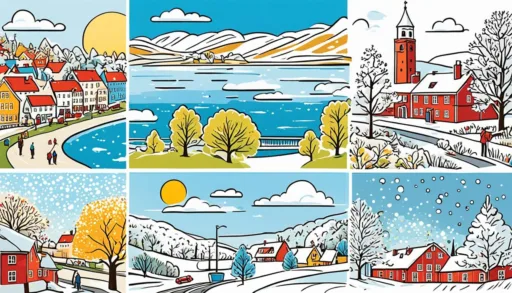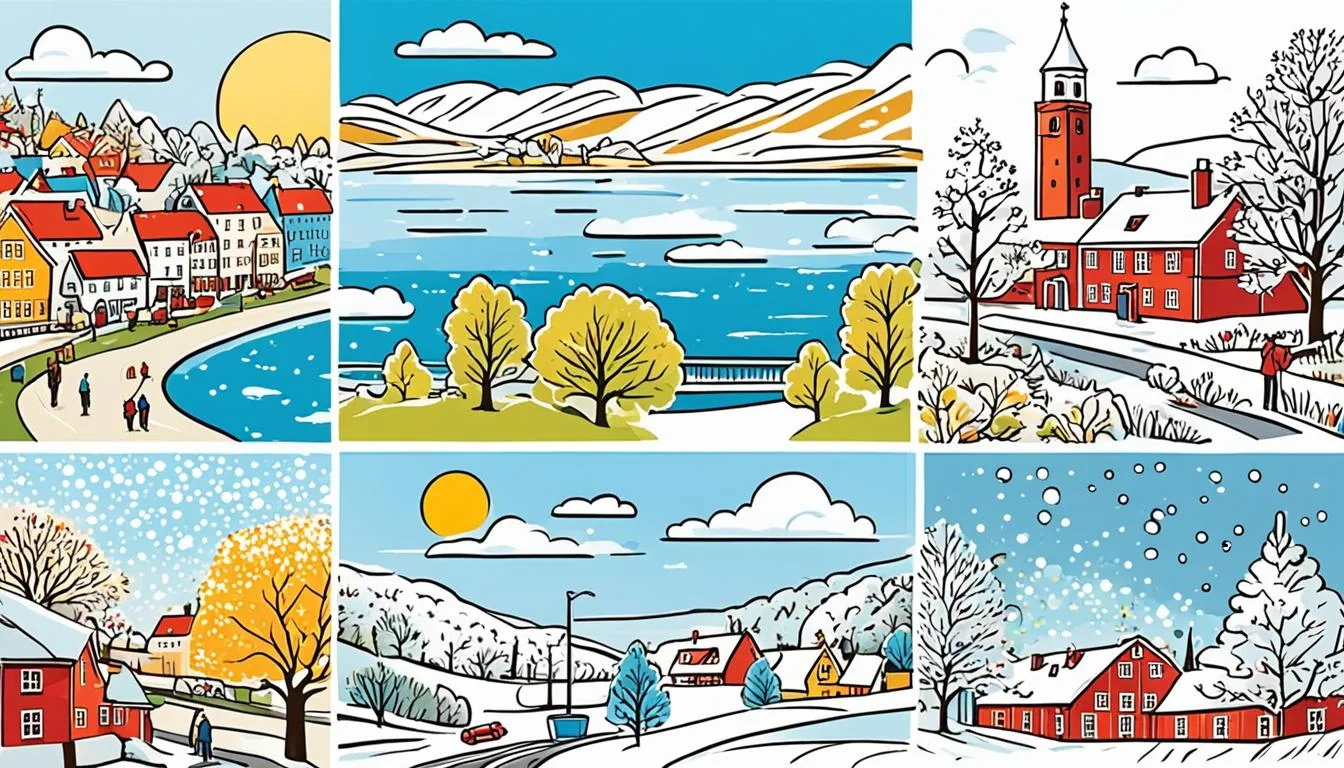Have you ever wondered what makes Denmark a fascinating travel destination year-round? Is it the lure of Hygge experiences on chilly nights, the charm of long summer days, or the allure of colorful autumns that captivates the hearts of travelers? Embark on a Danish adventure as we unveil the best time to visit Denmark, guiding you through each season’s unique offerings. This seasonal guide isn’t just about weather patterns—it’s about finding the right moment for your Danish dream. From cultural festivities in the heart of Copenhagen to serene landscapes on the outskirts, identifying the ideal months for a Denmark visit is key to making the most of your Scandinavian journey.
Key Takeaways
- Identify the peak Denmark travel season and off-peak alternatives for a more intimate experience.
- Learn about the renowned Hygge experiences and how you can embrace them during your visit.
- Discover the festive atmosphere and natural beauty that defines the Danish lifestyle across different seasons.
- Gain insight into the bustling summer days and the cozy ambiance of a traditional Danish winter.
- Find out why shoulder months may offer the perfect balance between pleasant weather and cultural exploration in Denmark.
- Understand the attractions and activities unique to each part of the year in this captivating Nordic country.
Embracing the Danish Seasons: An Overview
Denmark, with its temperate climate, beckons travelers to a land where each season paints a unique storybook setting. The Denmark travel season invites you to immerse yourself in Hygge experiences satiating the soul, irrespective of the Danish weather outside. To discover the heart of Denmark, one must delve into the seasonal variations, revealing the vibrant tapestry of Danish cultural life and natural splendor.
Winter in Denmark is a time when twinkling lights adorn streets, and markets radiate warmth amidst the chill. Despite the shorter daylight hours, a stroll through Copenhagen’s Christmas markets can kindle the cozy essence of Hygge. A Copenhagen weather guide during this chilly season highlights the need for warm layers, but also promises the joy of heartening indoor retreats.
As the chill thaws, spring ushers in milder, queue-free days ideal for blooming cherry blossoms and languid park lounging. Culinary aficionados relish in spring as festivals like the Copenhagen Cooking & Food Festival animate the cityscape, signaling the kick-off to the tourist season in Denmark.
Summer bestows an energetic boost to city life, with sun-kissed beaches and legendary music festivals like Roskilde, encapsulating the essence of Scandinavian leisure. It’s the season when outdoor café terraces are abuzz, and a balmy breeze carries the sounds of celebration across the city.
- Life’s a Beach: Embrace the sun and sea at Amager Strandpark
- Festival Vibes: Join the crowds in revelry at Roskilde or Smukfest
Time seems to slow in fall, and Denmark’s autumnal cloak beams with reds and golds. It’s the underestimated gem of the tourist calendar, where harvest festivals lend a chance to savor local produce, and the dwindling number of tourists crafts a tranquil landscape for all who venture here.
Understanding these seasonal moods is key to planning your visit. Whether you’re pursuing the languid joys of a sunny day or the intimate embrace of winter’s Hygge, the Danish weather and calendar set the stage for unforgettable moments across this timeless Scandinavian nation.
Best Time to Visit Denmark
When planning a trip to Denmark, considering the Denmark travel season can significantly enhance your experience. Each period of the year unfolds unique aspects of Danish culture and climate, making the ideal months for Denmark visit dependent on your personal preferences and the adventures you’re seeking.
The Charm of Danish Springs: April to June
Experience Spring in Denmark during April to June, where the weather transitions into blue skies and moderate temperatures. It’s a time with fewer crowds, allowing for a peaceful exploration of Denmark’s awakening landscapes. Enjoy outdoor attractions and events such as the colorful Independence Day celebrations, a significant addition to any Copenhagen weather guide.
Long Days and Lively Nights: Summer in Denmark
Summer in Denmark brings forth the quintessential Scandinavian lifestyle with long daylight hours and a spirited atmosphere. From June to August, being the peak tourist season in Denmark, it offers perfect weather for beach enthusiasts and festival-goers who immerse themselves in the vibrant Danish summertime.

The Golden Touch of Autumn: September to October
Witness the Autumn in Denmark as the landscape wears a golden hue from September to October. The country’s natural beauty is accentuated with a palette of fall colors, and the off-peak travel Denmark season ensures a tranquil environment with reasonable tourist numbers, creating a perfect setting for nature-lovers and culture enthusiasts alike.
A Cozy Danish Winter: Embracing Hygge from November to March
Immerse yourself in the heart of Danish culture by experiencing a cozy winter travel in Denmark. From November to March, Denmark’s renowned hygge experiences come to life amidst snowy days. Delight in the charming Danish Christmas markets and take pleasure in the reduced rates of off-peak travel during Denmark’s winter months.
A Month-by-Month Copenhagen Weather Guide
Copenhagen’s climate exhibits profound seasonal changes, influencing both the landscape and the activities available to visitors. Understanding the Copenhagen weather guide is crucial for planning your journey, pinpointing the Best Time to Visit Denmark to align with your travel preferences. Whether it’s embracing the vibrant Denmark travel season or opting for a tranquil escape during the off-peak tourist season in Denmark, here’s what to expect throughout the year.
Spring unfolds with blooming flowers and increasingly warmer days, indicating a renaissance of outdoor pursuits. By contrast, summer brings extended stretches of daylight, perfect for enjoying the bustling city life and captivating festivals. The enchanting transition of autumn paints the city in warm hues and creates an idyllic setting for walks in the city’s parks. Meanwhile, winter offers a markedly different charm, with festive lights and the cozy ambiance of Danish hygge in the air.
“Each season paints Copenhagen in its unique colors, shapes, and temperaments, offering a fresh palette of experiences for every type of traveler.”
| Month | Weather | Activities | Travel Tip |
|---|---|---|---|
| January | Chilly and brisk | Indoor cultural experiences | Explore museums and cozy cafes |
| February | Cold with brief daylight | Copenhagen Light Festival | Carry warm attire and enjoy fewer crowds |
| March | Start of spring | Beginning of outdoor activities | Watch the city come to life |
| April | Milder temperate climate | Parks and outdoor cafes | Experience the cherry blossoms |
| May | Warm and pleasant | Biking and city tours | Enjoy the prelude to summer |
| June | Beginning of summer | Outdoor festivals and events | Book accommodations in advance |
| July | Warm with long daylight hours | Beaches and outdoor dining | Participate in summer celebrations |
| August | Peak summer weather | Late-night city exploration | Enjoy the vibrant nightlife |
| September | Start of fall | Cultural festivals and harvests | Witness the foliage change |
| October | Crisp and cool | Quiet sightseeing | Opt for scenic nature walks |
| November | Darker and cooler days | Pre-Christmas festivities | Begin holiday market visits |
| December | Winter sets in | Christmas markets and lights | Embrace the holiday spirit |
The beauty of Copenhagen lies in its seasonal versatility—there’s always something to experience regardless of the weather. Whether you seek exhilarating summer activities or the warmth of winter attractions, your journey through the seasons of Copenhagen promises to be as enchanting as it is memorable.
Understanding Denmark Travel Seasons: From Peak to Off-Peak
Denmark, with its distinct travel seasons, offers a plethora of experiences that cater to a variety of preferences and interests. Whether you crave the vibrant festivities of the peak tourist season or yearn for the calmness of the off-peak travel months, Denmark’s climate and cultural panorama provide ample choice for your Nordic adventure. Discover when the landscape comes alive with the Scandinavian sun and when the serene Danish lifestyle can be savored at its purest form.
June to August: Savoring the Scandinavian Sun
The warm rays of the Scandinavian sun from June through August signal the peak tourist season in Denmark. During these summer months, Denmark is abuzz with life and color, offering the ideal travel season for outdoor enthusiasts. Long daylight hours bring forth a multitude of festivals, such as the Roskilde Music Festival and Copenhagen Jazz Festival, filling the air with melody and cheer. It’s a time when locals and tourists mingle in the city streets, basking in the energetic summer vibe that pervades throughout the country.
April to May and September to November: The Shoulder Seasons
Transitioning from the peaks of summer or preparing for winter’s embrace, the shoulder seasons of April to May and September to November are among the ideal months for a Denmark visit. The shoulder season travels present a serene opportunity for tourists to enjoy the milder weather, with a more intimate and authentic experience of Denmark’s cultural offerings. These months strike a perfect balance, affording visitors with comfortable weather in Denmark for tourists, allowing for the discovery of Denmark’s verdant landscapes without the summer crowds.
January to March: The Serenity of Off-Peak Travels
Off-peak travel in Denmark, particularly from January to March, unfolds a canvas where the soothing tranquility of Danish life takes center stage. It’s a time where the city’s pace is unhurried and the Copenhagen weather guide hints at crisp days and cozy evenings. This period appeals to those seeking solitude and cultural enrichment, with the added benefit of winter travel tips in Denmark that include enjoying lower accommodation rates and undisturbed visits to Denmark’s esteemed landmarks. As the country wraps itself in a wintry chill, the heart of Denmark can be felt through its culinary delights and the comfort of its legendary hygge hospitality.
FAQ
What is the best time to visit Denmark?
The best time to visit Denmark often depends on what you’re looking for. For mild weather and long days, visit during the summer months of June to August. If you prefer fewer crowds and pleasant weather, April to June or September to November during the shoulder seasons might be ideal. For cozy indoor activities and festive Christmas markets, November to March is perfect to enjoy hygge culture.
When is the peak tourist season in Denmark?
Peak tourist season in Denmark is during the summer, from June to August, when the country enjoys long days and milder weather, perfect for a host of outdoor activities and festivals.
Are there any benefits to visiting Denmark in the off-peak season?
Yes, visiting Denmark in the off-peak months of January to March can lead to discounts on accommodation, fewer tourists at attractions, and a more authentic experience of Danish daily life.
What weather can I expect in Denmark throughout the year?
Denmark has a temperate climate with warm summers and cold winters. Expect long days and mild temperatures in the summer, and short, dark, and chilly days in the winter. Spring and autumn offer mild weather, ideal for enjoying the outdoors.
How can I experience hygge during my visit to Denmark?
To experience hygge, visit during the colder months from November to March. Embrace the indoor coziness of Danish cafes, enjoy the Christmas markets, and participate in cultural events like the Copenhagen Light Festival.
What activities are best suited for spring in Denmark?
Spring in Denmark, especially from April to June, is perfect for outdoor activities such as visiting parks, enjoying cafés, and attending cultural festivals like the Copenhagen Cooking & Food Festival.
What makes Danish summers unique?
Danish summers are unique for the extensive daylight hours—up to 18 hours of daylight in June—allowing for long days spent outdoors. The weather is conducive to beach outings, music festivals like Roskilde, and various other summer activities.
Why might someone choose to visit Denmark in autumn?
Autumn in Denmark is appealing for its cooler but comfortable weather, the colorful fall landscapes, and the reduced crowd levels. It’s a great time for nature walks, bird watching, and enjoying cultural events such as the Copenhagen Blues Festival.
What are the typical weather conditions in Copenhagen?
Copenhagen’s typical weather conditions include warm summers, chilly winters, and mild temperatures during spring and autumn. Rain is frequent year-round, so packing waterproof clothing is advisable.
When is the best time to enjoy Denmark’s beaches?
The best time to enjoy Denmark’s beaches is during the summer months from June to August when the weather is warmest and the water temperatures are more comfortable for swimming.






